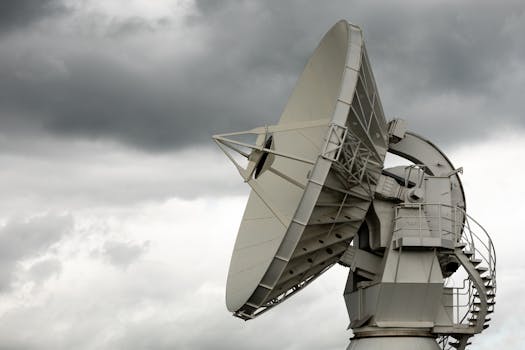GEO Satellites: Understanding the Technology and Its Applications
GEO satellites play a crucial role in modern telecommunications, providing a wide range of services including television broadcasting, telecommunications, and weather forecasting. This article delves into the technology and applications of GEO satellites, exploring their importance in the telecommunications industry.

GEO Satellites: Understanding the Technology and Its Applications
GEO satellites, or Geostationary Earth Orbit satellites, are a type of satellite that orbits the Earth at an altitude of approximately 36,000 kilometers above the equator. At this altitude, the satellite’s orbital period matches the Earth’s rotational period, allowing it to remain stationary over a fixed point on the Earth’s surface. This unique characteristic makes GEO satellites ideal for a variety of applications, including television broadcasting, telecommunications, and weather forecasting.
The technology behind GEO satellites is complex and involves a range of components, including the satellite itself, the launch vehicle, and the ground control system. The satellite is equipped with a range of instruments, including transponders, antennas, and solar panels, which enable it to receive and transmit signals, as well as generate power. The launch vehicle is responsible for propelling the satellite into orbit, while the ground control system monitors and controls the satellite’s operations.
Applications of GEO Satellites
GEO satellites have a wide range of applications, including television broadcasting, telecommunications, and weather forecasting. In the field of television broadcasting, GEO satellites are used to transmit signals to reception dishes on the ground, allowing for the broadcast of television channels to a wide audience. In telecommunications, GEO satellites are used to provide internet connectivity, voice communications, and other data services to remote or underserved areas. Weather forecasting is another important application of GEO satellites, as they are used to collect data on atmospheric conditions, sea surface temperatures, and other environmental factors.
In addition to these applications, GEO satellites are also used for a range of other purposes, including navigation, Earth observation, and scientific research. For example, the Global Positioning System (GPS) relies on a network of GEO satellites to provide location information to users. Earth observation satellites use instruments such as cameras and spectrometers to collect data on the Earth’s surface and atmosphere, while scientific research satellites are used to study the Earth’s magnetic field, the Sun, and other celestial bodies.
Benefits and Challenges of GEO Satellites
The use of GEO satellites offers a range of benefits, including global coverage, high bandwidth, and reliability. GEO satellites can provide services to a wide audience, regardless of geographical location, and offer high-speed data transfer rates. They are also highly reliable, with some satellites operating for 15 years or more. However, there are also challenges associated with the use of GEO satellites, including the high cost of launch and operation, the risk of satellite failure, and the potential for interference from other satellites or terrestrial systems.
Despite these challenges, the demand for GEO satellites is expected to continue to grow in the coming years, driven by the increasing need for telecommunications services, particularly in remote or underserved areas. The development of new technologies, such as high-throughput satellites and satellite constellations, is also expected to play a major role in shaping the future of the GEO satellite industry.
Conclusion
In conclusion, GEO satellites play a crucial role in modern telecommunications, providing a wide range of services including television broadcasting, telecommunications, and weather forecasting. The technology behind GEO satellites is complex, involving a range of components and systems. While there are challenges associated with the use of GEO satellites, the benefits they offer, including global coverage, high bandwidth, and reliability, make them an essential part of the telecommunications industry. As the demand for telecommunications services continues to grow, the importance of GEO satellites is likely to increase, driving innovation and investment in the industry.